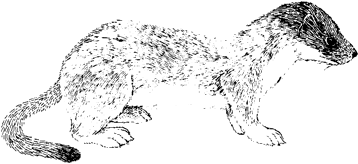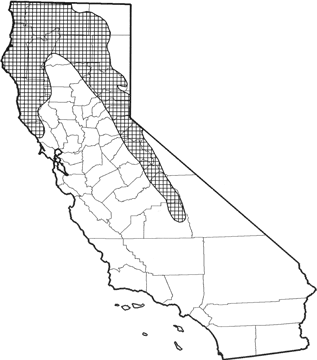
Ermine
Distribution, Abundance, and Seasonality
Uncommon to common, yearlong resident of the Sierra Nevada, Klamath, and North Coast Ranges (Ingles 1965). Found from sea level to 3800 m (0-12,500 ft). Occurs in various pine and fir forest habitats, including mixed conifer, red fir, lodgepole pine, and subalpine conifer (Seymour 1968, Burt and Grossenheider 1976).

Range Map
Specific Habitat Requirements
Feeding: Ermines are carnivorous. They eat small mammals, especially voles, also shrews, shrew-moles, immature rabbits, chipmunks, deer mice, jumping mice, and house mice. Other prey include small birds, frogs, small fish, and earthworms. Forage widely day and night, above and below ground and snow, in rock areas, in snags, stumps, and logs. Pursue small mammals into their own tunnels, runways, and burrows. Search for, and pursue, then kill prey by biting at base of skull.
Cover: Most cover for this weasel is provided by natural cavities in stumps, logs, uprooted trees, rock areas, burrows, or under human structures.
Reproduction: Den under stumps, logs, uprooted trees, rocks, human structures, or in burrows. Often use nests of prey, lined with hair from prey carcasses.
Water: No data found on water requirements. Probably need to drink.
Pattern: Ermines use mature, dense stages of forest habitats for breeding, and adjacent lower seral stages (grass/forb) and forest/meadow ecotones for feeding.
Species Life History
Activity Patterns: Active yearlong; nocturnal and diurnal.
Seasonal Movements / Migration: Non-migratory.
Home Range: Burt and Grossenheider (1976) reported that home ranges varied from 10-15 ha (25-37 ac).
Territory: No data found on territories.
Reproduction: Apparently breed in late spring and summer. Gestation period approaches 255 days, including delayed implantation. Embryos implant and begin development about 8 wk prior to birth (Jackson 1961). Litter size averages 4-6, and ranges from 4-13 (Hall 1951, Maser et al. 1981). One litter/yr; both parents care for young, which are weaned at about 5 wk. Females become mature sexually during first summer and usually mate, bearing first litter the following spring. Males probably not mature sexually until 1 yr old (Maser et al. 1981).
Niche: Ermines are prey for minks, martens, fishers, bobcats, coyotes, and large owls and hawks; domestic dogs and cats also kill a few. Population numbers vary with small mammal population fluctuations. Ermines usually change pelage color from brown to white when snow covers the ground (Haley 1975). Ermines potentially compete for food with owls, hawks, coyotes, bobcats, long-tailed weasels, and minks. Agility, small size, and slender shape provide specialization as a predator of small mammals (King 1983).
Sources & References
California Department of Fish and Game, 1999.
California's Wildlife, Sacramento, CA.
Written by: G. Ahlborn, reviewed by: M. White, edited by: G. Ahlborn, M. White
Burns, J. J. 1964. Movements of a tagged weasel in Alaska. Murrelet 45:10. Burt, W. H., and R. P. Grossenheider. 1976. A field guide to the mammals. 3d ed. Houghton Mifflin Co, Boston, MA. 289pp. Haley, D. 1975. Sleek and savage: North America's weasel family. Pacific Search Books, Seattle, WA. 128pp. Hall, E. R. 1951. American weasels. Univ. Kansas Mus. Nat. Hist. Vol. 4. 466pp. Ingles, L. G. 1965. Mammals of the Pacific states. Stanford Univ. Press, Stanford, CA. 506pp. Jackson, H. H. T. 1961. Mammals of Wisconsin. Univ. Wisconsin Press, Madison. 504pp. King, C. M. 1983. Mustela erminea. Mammal. Species No. 195. 8pp. Maser, C., B. R. Mate, J. F. Franklin, and C. T. Dyrness. 1981. Natural history of Oregon coast mammals. Pac. Northwest For. And Range Exp. Sta., USDA, For. Serv., Gen. Tech. Rep., PNW-133. 496pp. Schempf, P. F., and M. White. 1974. A survey of the status of seven species of carnivores on National Park Service lands in California. Dep. For. And Conserv., Univ. Calif., Berkeley. 129pp. Seymour, G. 1968. Furbearers of California. Calif. Dep. Fish and Game, Sacramento. 55pp.
California Animal Facts | California's Wildlife